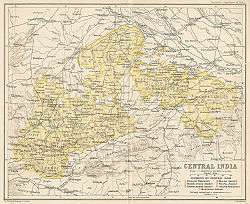Bagelkhand Agency
| Bagelkhand Agency | |||||
| Agency of British India | |||||
| |||||
 | |||||
| History | |||||
| • | Established | 1871 | |||
| • | Disestablished | 1933 | |||
| Area | |||||
| • | 1901 | 37,100 km2 (14,324 sq mi) | |||
| Population | |||||
| • | 1901 | 1,555,024 | |||
| Density | 41.9 /km2 (108.6 /sq mi) | ||||
| | |||||
The Bagelkhand Agency was a British political unit which managed the relations of the British with a number of autonomous princely states existing outside British India, namely Rewa and eleven minor states, of which the more important were Maihar, Nagod —with its capital at Uuchahara— and Sohawal. The less important states included Jaso State, Kothi, Baraundha, also known as Patharkachhar, as well as the Kalinjar Chaubes —consisting of the princely estates of Paldeo, Kamta-Rajaula, Taraon, Pahra and Bhaisaunda.[1]
History
The Agency was established in March 1871 and was named after the Bagelkhand region. From 1871 to 1933 the Agency was under the political supervision of the Governor-General of India's Agent for Central India, and under the direct supervision of a political Agent who was also the appointed Resident to Rewa State, residing ordinarily at Satna or Rewa.
The total area was 14,323 square miles (37,100 km2), and the population in 1901 was 1,555,024, a decrease of 11% over the previous census ten years before, largely due to the results of famine. The rainfall was very deficient in 1895-1897, causing a famine in 1897; and in 1899-1900 there was another drought in some states. In 1931, the eleven smaller states were transferred to the Bundelkhand Agency, and in 1933 the agency was dissolved, when Rewa State joined the Indore Residency.[2]
After the partition of British India into two independent states in 1947, the princely states that made up the Baghelkhand Agency all chose to accede to the new Union of India and were merged with Rewa to form the new Vindhya Pradesh, which was in turn merged into Madhya Pradesh on November 1, 1956.
Princely States
The Bagelkhand Agency, the easternmost charge of the Central India Agency, was established in March 1871, when it was separated from Bundelkhand Agency. In 1900, it had relations with twelve princely states :
Three Salute states, by precedence :
- Rewa, the largest state in Bagelkhand, title Maharaja, entitled to a Hereditary salute of 17-guns
- Baraundha, title Raja, Hereditary salute of 9-guns
- Maihar, title Raja, Hereditary salute of 9-guns
Nine non-salute states (alphabetically) :
In 1931, the agency of all of the states but Rewa was transferred back to Bundelkhand, and in 1933 Rewa joined the Indore Residency.
See also
References
- ↑ Malleson, G. B. An historical sketch of the native states of India, London 1875, Reprint Delhi 1984
- ↑
 This article incorporates text from a publication now in the public domain: Chisholm, Hugh, ed. (1911). "article name needed". Encyclopædia Britannica (11th ed.). Cambridge University Press.
This article incorporates text from a publication now in the public domain: Chisholm, Hugh, ed. (1911). "article name needed". Encyclopædia Britannica (11th ed.). Cambridge University Press.